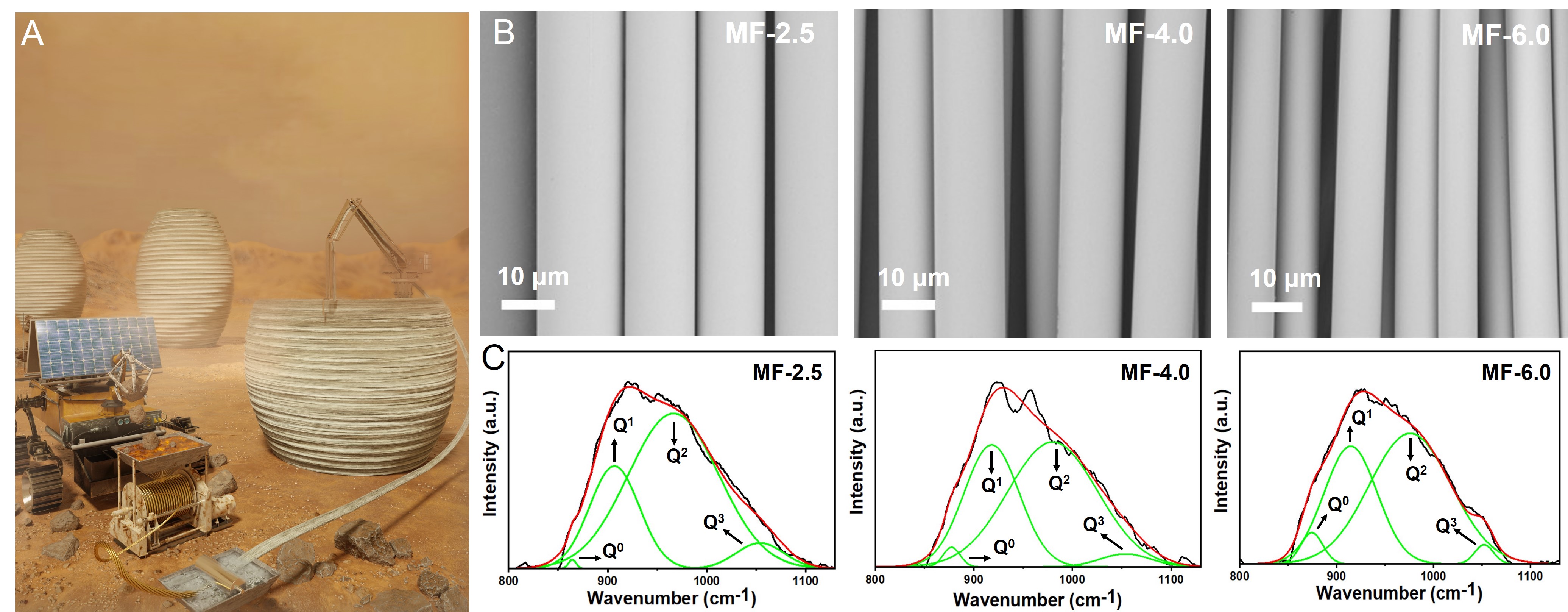Research Progress in the Field of In-situ Preparation of Continuous Fibers Using Martian Soil
Editor: | Aug 28,2024
Mars is considered the most suitable planet for human habitation in the solar system after Earth and serves as the starting point for human exploration of the vast universe. In recent years, the construction of Mars bases has garnered attention from various countries and research organizations. The Martian surface is covered with a layer of Martian regolith, and the in-situ utilization of Martian resources can significantly reduce the construction costs of the bases while enhancing the sustainability of human life on Mars. Composite materials are binary or multi-component hybrid systems composed of a matrix and a reinforcement. The constituent materials complement each other in performance, creating a synergistic effect that results in the composite material having superior overall performance compared to the original constituent materials, thus meeting various requirements. Therefore, if Martian resources can be in-situ utilized to obtain the matrix and reinforcement and then made into composite materials, it can greatly reduce the dependence on Earth's resources during the construction and operation of Mars bases.
Recently, a research team from the Xinjiang Technical Institute of Physics and Chemistry Chinese Academy of Sciences, in collaboration with the Institute of Geochemistry Chinese Academy of Sciences and the Chinese University of Hong Kong (Shenzhen), has taken the demand for high-performance reinforcement materials in the construction of Mars bases as a starting point to explore the feasibility of using Martian soil to prepare continuous fibers for the construction of Mars bases (as shown in Figure 1A). The research results indicate that Martian soil has a chemical composition, mineral phase composition, and melting behavior similar to Earth's basalt. Simulated Martian soil was found to be completely molten at 1360 oC, with no apparent crystallization during the melting-cooling process, and the melt was transformed into an amorphous glass body after quenching. Guided by these experimental results, researchers obtained continuous Martian soil fibers using the melt-spinning method at different fiber-drawing speeds (2.5, 4.0, and 6.0 m/s) (as shown in Figure 1B). The average diameter of the obtained fibers was 9.7-13.9 μm, with a maximum tensile strength of 1320 MPa and a maximum tensile modulus of 99 GPa. The study also found that as the fiber-drawing speed increased, the tensile strength and Young's modulus of the fibers decreased, which may be due to the drawing speed affecting the aggregation state structure of the atoms in the fibers. Silicon is the main element in the Martian soil fibers, with a content exceeding 45 wt% (calculated as SiO2). Silicon atoms form tetrahedral structures with oxygen atoms, thereby forming network units in the fibers. An oxygen atom linking two silicon atoms is a bridging oxygen, otherwise it is a non-bridging oxygen. Generally, the more bridging oxygen bonds in the silicate system, the higher the polymerization degree of the network formed by the silicon atoms. Researchers used Raman spectroscopy combined with Gaussian peak fitting to confirm that the polymerization degree of the Martian soil fibers decreased with the increase of the fiber-drawing speed, specifically manifested by the gradual decrease in the peak area representing the silicon-oxygen tetrahedra with three bridging oxygens (as indicated by Q3 in Figure 1C). This proves that Martian soil fibers prepared at a lower drawing speed have a denser atomic structure, making them more resistant to external damage, and thus having better mechanical properties. In addition, researchers combined the environmental conditions of Mars, such as low gravity and special atmosphere (low pressure and inert atmosphere), to analyze the impact of these factors on the fiber-spinning process and performance. The research results confirm that continuous, diameter-controllable fiber materials can be obtained using Martian soil as the raw material. The fibers obtained are expected to enable the preparation of fiber-reinforced composite materials through composite technology, which has significant application value for the in-situ construction of Mars bases using Martian soil.
The aforementioned research findings were recently published in the journal iScience (iScience, 2024, 27, 110408).

Figure 1: Schematic of the concept for preparing continuous fibers from Martian soil for the construction of Mars bases (A), and the microstructure (B) and structural characterization (C) of Martian soil fibers produced at different fiber-drawing speeds.
附件下载:
 (86) 991-3838931
(86) 991-3838931 lhskj@ms.xjb.ac.cn
lhskj@ms.xjb.ac.cn (86)991-3838957
(86)991-3838957 40-1 Beijing Road
Urumqi, XinjiangChina
40-1 Beijing Road
Urumqi, XinjiangChina